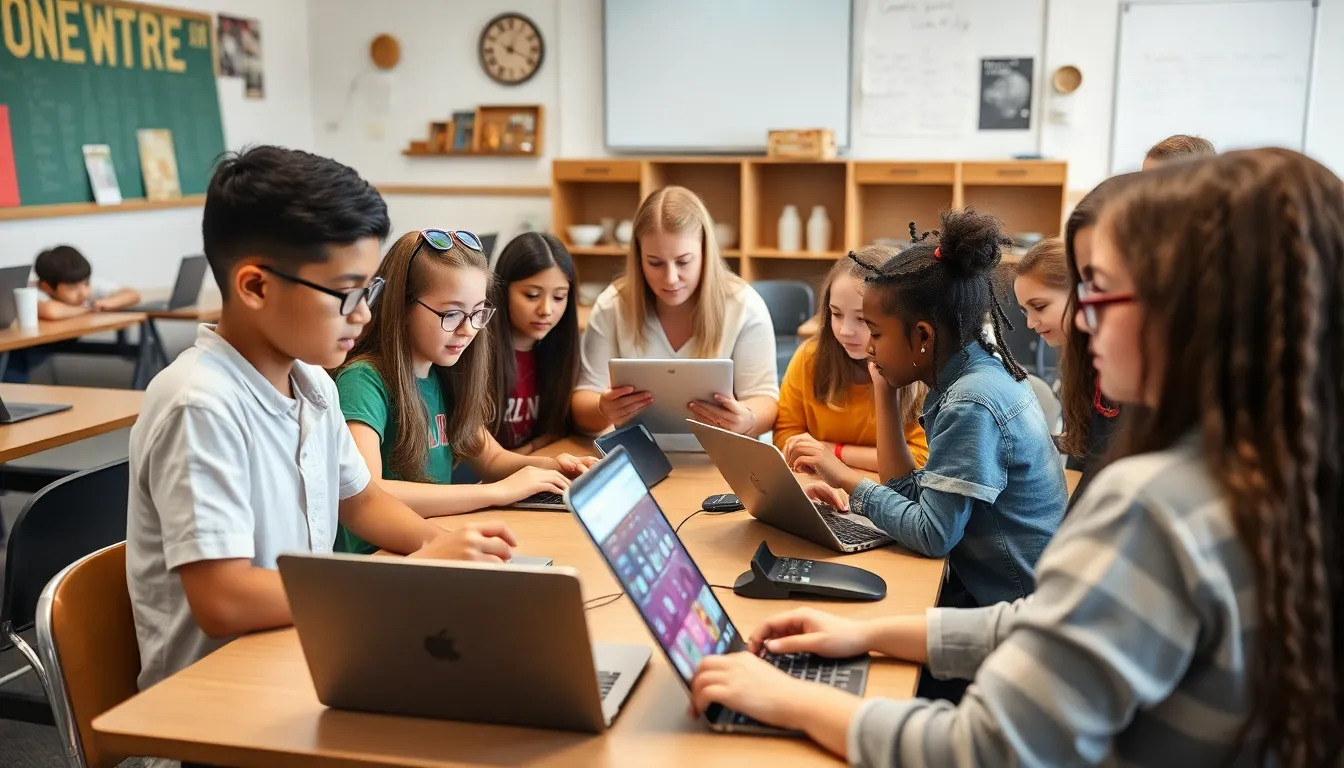Table of Contents
ToggleIn today’s digital jungle, tech literacy isn’t just a nice-to-have; it’s a survival skill. Imagine trying to navigate a smartphone like a caveman with a rock—frustrating, right? Enhancing tech literacy can turn that confusion into confidence, helping everyone from students to seniors tackle the tech world with ease.
With the rapid pace of innovation, keeping up can feel like trying to outrun a cheetah on roller skates. But fear not! Learning the ropes of technology can be fun and engaging. Whether it’s mastering the latest app or understanding the mysterious cloud, boosting tech skills can open doors to new opportunities and make life a whole lot easier. So let’s dive into the world of tech literacy and discover how anyone can become a savvy digital citizen.
Understanding Tech Literacy
Tech literacy represents the ability to effectively use technology tools and understanding how they impact daily life. Mastery of these skills is vital in today’s digital landscape.
Definition of Tech Literacy
Tech literacy encompasses the skills required to navigate and understand technology. It includes knowing how to operate devices like computers and smartphones, using applications effectively, and understanding digital safety and etiquette. Individuals who possess tech literacy can access information online, solve problems using technology, and communicate effectively across various platforms. Gaining proficiency in these areas enables seamless interaction within increasingly digital environments.
Importance of Tech Literacy
Tech literacy plays a crucial role in personal and professional development. It empowers individuals to access educational resources, enhancing learning outcomes. In the workplace, tech-savvy employees tend to outperform their peers by efficiently utilizing digital tools, leading to improved productivity. Furthermore, understanding technology fosters inclusivity, allowing diverse groups to engage and participate in the digital economy. As technology advances, possessing tech literacy ensures that individuals remain competitive and adaptable in a rapidly changing job market.
Strategies to Enhance Tech Literacy


Enhancing tech literacy requires a multifaceted approach that engages various learning environments and resources.
Integrating Technology in Education
Schools play a pivotal role in fostering tech literacy. Incorporating technology into the curriculum encourages students to explore digital tools and platforms. Teachers can integrate coding, digital literacy classes, and online collaboration projects. These methods not only teach technical skills but also promote critical thinking. Engaging students in project-based learning that utilizes technology builds confidence in their capabilities. Additionally, educators can arrange workshops for both students and parents to bridge the digital divide.
Utilizing Online Resources
Numerous online resources aid in improving tech skills. Websites like Codecademy and Coursera offer free and paid courses that cater to various skill levels. Engaging with online tutorials and forums can enhance understanding. Many YouTube channels provide step-by-step guides on specific applications and technologies. Educational podcasts also share insights into the latest tech trends and tools. Accessing these resources ensures learners stay informed and proficient in today’s digital landscape. Community webinars and virtual meet-ups facilitate interaction and knowledge sharing, further solidifying tech literacy.
Benefits of Enhanced Tech Literacy
Enhancing tech literacy brings numerous advantages in various aspects of life. Increased proficiency with technology opens doors for individuals in multiple ways.
Improved Job Opportunities
Tech literacy significantly improves job opportunities. Employers consistently seek candidates with technology skills. Proficiency in software applications, data analysis, and digital communication enhances an individual’s appeal. Competitors in the job market with strong tech abilities stand a better chance of securing desirable positions. According to a report from the World Economic Forum, 85 million jobs may be displaced by the shift towards automation, but 97 million new roles will emerge, underscoring the importance of tech-savvy professionals. Because industries increasingly rely on technology, even non-tech roles expect employees to navigate digital tools efficiently.
Increased Access to Information
Enhanced tech literacy leads to increased access to information. Understanding digital platforms allows individuals to seek knowledge easily. Online resources, educational websites, and databases become more navigable for those with strong tech skills. For instance, learners can explore MOOCs (massive open online courses) from platforms like edX and Khan Academy. Accessing up-to-date information on trends in various fields becomes simpler with tech proficiency. This allows for informed decision-making, both personally and professionally. Additionally, individuals gain an ability to collaborate effectively through online tools, further amplifying their access to a wealth of resources and expertise.
Challenges in Enhancing Tech Literacy
Enhancing tech literacy faces several significant challenges. Addressing these hurdles is essential for promoting broader engagement with technology.
Digital Divide
The digital divide represents a gap where some groups lack access to technology and the internet. Low-income families or rural communities often experience this disparity, limiting their ability to develop tech skills. Statistics indicate that approximately 25% of households in the U.S. do not have high-speed internet access. This lack of resources restricts opportunities for learning and engagement, obstructing personal and professional growth. Bridging this gap demands investment in infrastructure and targeted programs that deliver devices and internet access to underserved populations.
Resistance to Change
Resistance to change hinders tech literacy initiatives significantly. Many individuals feel overwhelmed by the rapid evolution of technology. Unfamiliarity with new tools can foster anxiety, leading to avoidance rather than exploration. Surveys reveal that nearly 70% of adults express concern about their ability to keep pace with technological advancements. Overcoming this resistance involves creating supportive learning environments that encourage experimentation and offer reassurance. Building confidence in skills through exposure and practice can empower users to embrace technology rather than shun it.







